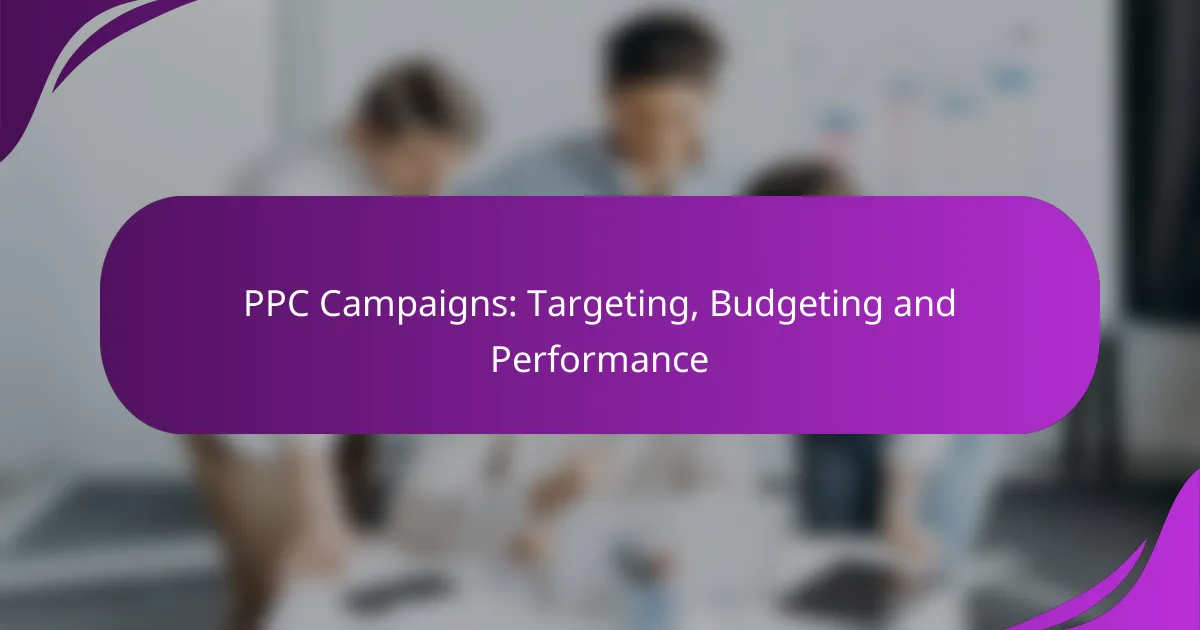PPC campaigns are a powerful tool for driving targeted traffic and increasing conversions. By focusing on precise keyword targeting, compelling ad copy, and effective landing page design, advertisers can enhance visibility and improve click-through rates. Additionally, implementing strategic budgeting and performance measurement is crucial for maximizing return on investment and ensuring the success of these campaigns.

How to optimize PPC campaigns in the UK?
To optimize PPC campaigns in the UK, focus on precise keyword targeting, compelling ad copy, and effective landing page design. These elements work together to enhance visibility, improve click-through rates, and increase conversions.
Keyword targeting strategies
Effective keyword targeting involves selecting relevant keywords that align with user intent and search behavior. Utilize tools like Google Keyword Planner to identify high-volume keywords and long-tail variations that can drive qualified traffic.
Consider negative keywords to filter out irrelevant searches, which can help improve your campaign’s efficiency. Regularly review and adjust your keyword list based on performance metrics to ensure you are targeting the most effective terms.
Ad copy best practices
Writing compelling ad copy is crucial for attracting clicks. Focus on clear, concise messaging that highlights the unique selling points of your product or service. Use strong calls to action to encourage users to take the next step.
Incorporate relevant keywords into your ad copy to improve quality scores and ad relevance. A/B testing different versions of your ads can help identify which messages resonate best with your audience, allowing for continuous improvement.
Landing page optimization
Your landing page should provide a seamless experience that aligns with your ad copy and keywords. Ensure that the page loads quickly and is mobile-friendly, as a significant portion of users will access it via smartphones.
Include clear and persuasive content, along with a prominent call to action. Use A/B testing to experiment with different layouts and messages, and analyze user behavior to identify areas for improvement. Aim for a conversion rate that meets or exceeds industry benchmarks for your sector.
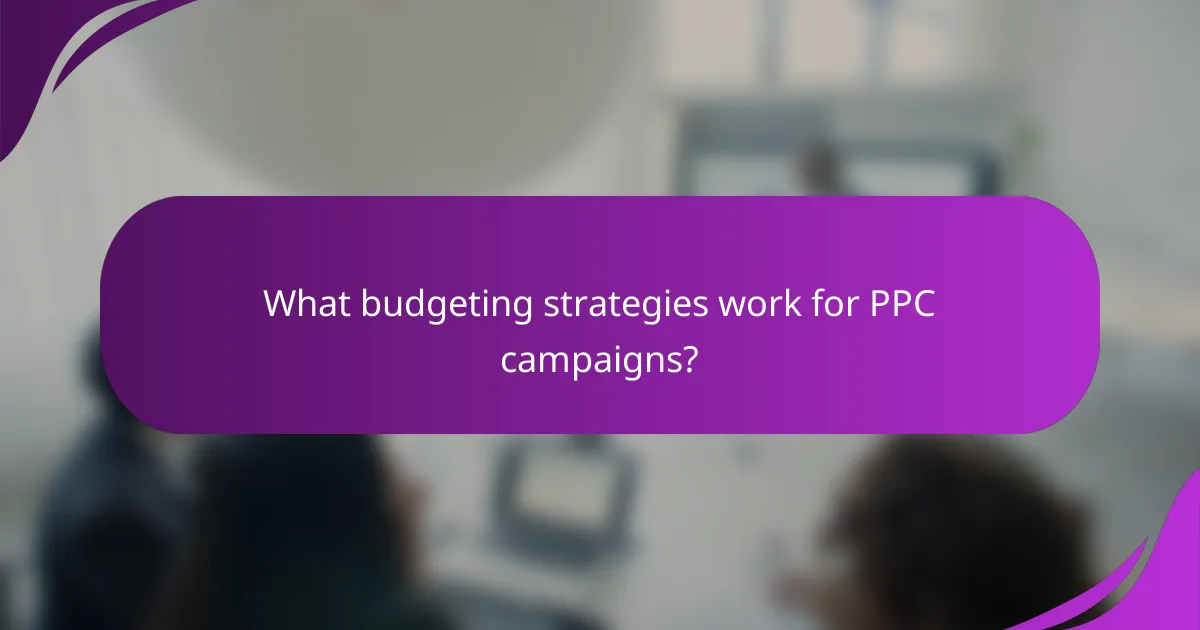
What budgeting strategies work for PPC campaigns?
Effective budgeting strategies for PPC campaigns involve setting clear financial limits while optimizing for performance. Key approaches include daily budget allocation and selecting appropriate bid strategies to maximize return on investment (ROI).
Daily budget allocation
Daily budget allocation refers to the amount of money you are willing to spend on your PPC campaigns each day. This strategy helps control costs and ensures that your ads remain active without overspending. A common practice is to set daily budgets based on your overall monthly budget divided by the number of days in the month.
When allocating your daily budget, consider factors such as peak traffic times and seasonal trends. For instance, if your business sees higher conversion rates during weekends, you might allocate a larger portion of your budget for those days. Regularly reviewing and adjusting your budget based on performance data is crucial for maintaining efficiency.
Bid strategies for maximum ROI
Bid strategies determine how much you are willing to pay for each click on your ads, directly impacting your overall ROI. Common strategies include manual bidding, automated bidding, and target CPA (cost per acquisition). Each method has its advantages and can be tailored to your campaign goals.
For example, manual bidding allows for precise control over bids for individual keywords, while automated bidding can optimize bids in real-time based on performance data. It’s essential to test different strategies to find the one that yields the best results for your specific campaigns. Regularly analyze performance metrics to refine your approach and avoid common pitfalls, such as overspending on low-performing keywords.
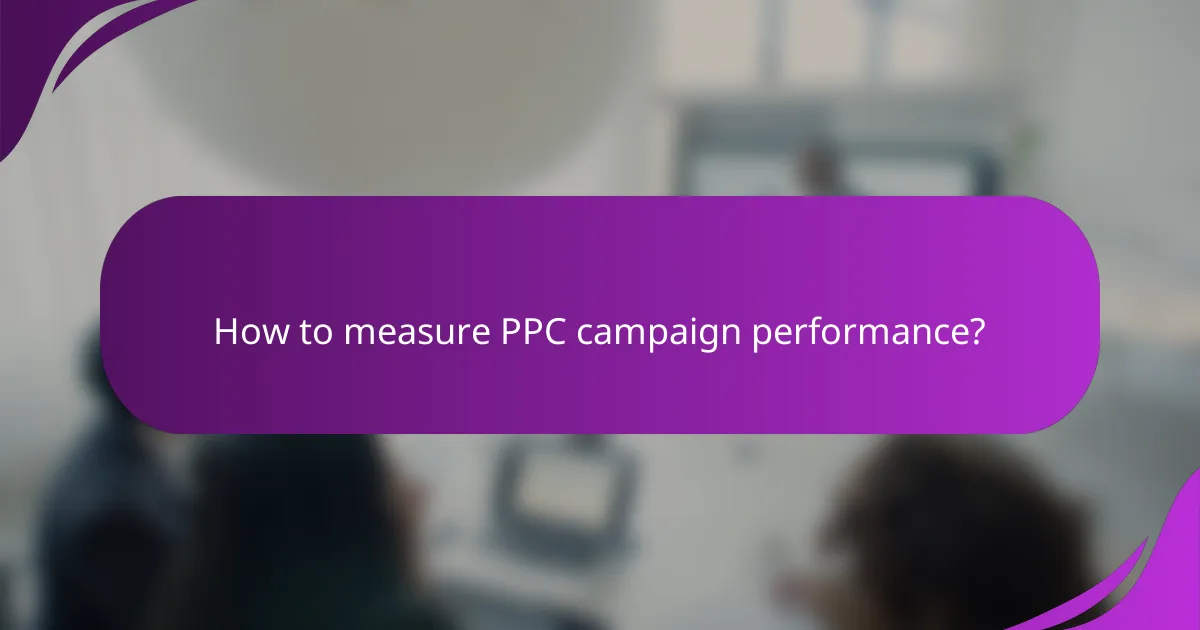
How to measure PPC campaign performance?
Measuring PPC campaign performance involves analyzing various metrics to determine the effectiveness of your advertising efforts. Key metrics help you understand how well your ads are performing and guide adjustments to improve results.
Key performance indicators (KPIs)
Key performance indicators (KPIs) are essential metrics that help evaluate the success of your PPC campaigns. Common KPIs include click-through rate (CTR), conversion rate, cost per click (CPC), and return on ad spend (ROAS). Each of these indicators provides insights into different aspects of campaign performance.
For instance, a high CTR indicates that your ads are engaging and relevant to your audience, while a low CPC suggests efficient spending. Aim for a conversion rate that aligns with industry benchmarks, typically ranging from 2% to 5% for many sectors.
Conversion tracking methods
Conversion tracking is crucial for understanding the effectiveness of your PPC campaigns. This process involves setting up tracking mechanisms to monitor actions taken by users after clicking on your ads, such as purchases or sign-ups. Google Ads and Facebook Ads offer built-in tools to facilitate this tracking.
Common methods include using tracking pixels, UTM parameters, and dedicated landing pages. For example, implementing a tracking pixel on your website can help you measure conversions directly linked to your ads. Ensure that your tracking setup complies with local regulations, such as GDPR in Europe, to protect user data.
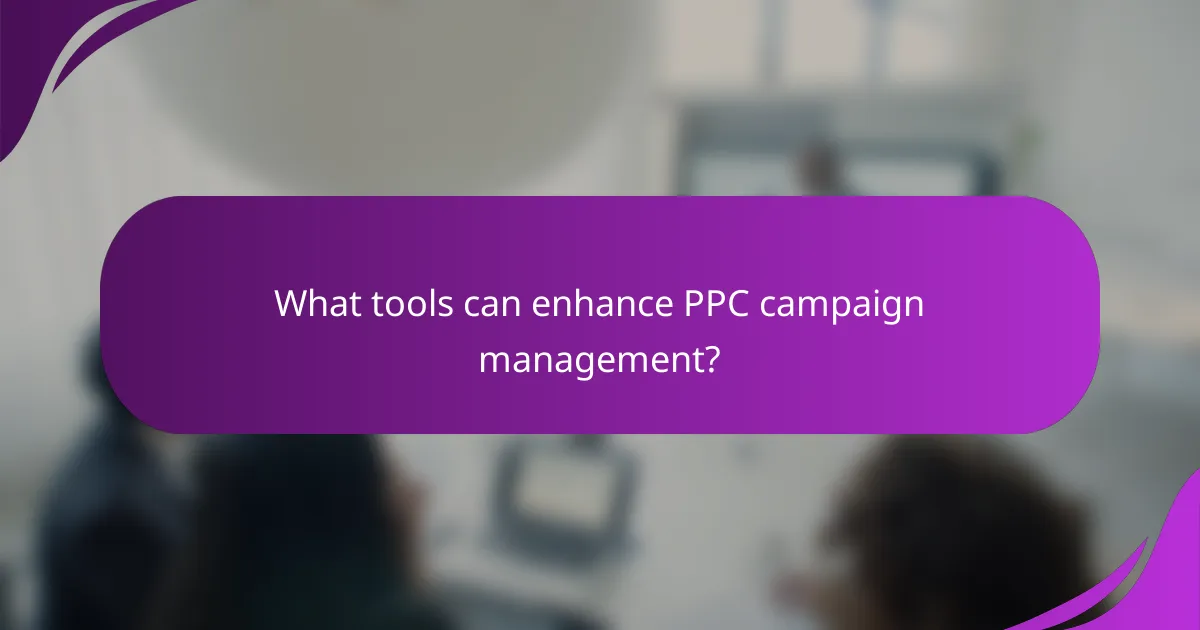
What tools can enhance PPC campaign management?
Several tools can significantly improve the management of PPC campaigns by streamlining processes, providing insights, and optimizing performance. Utilizing these tools effectively can lead to better targeting, budgeting, and overall campaign success.
Google Ads features
Google Ads offers a variety of features designed to enhance PPC campaign management. Key functionalities include keyword planning, ad extensions, and automated bidding strategies, which help advertisers optimize their campaigns based on performance data.
For instance, the Keyword Planner tool allows users to discover new keywords and see estimated search volumes, while ad extensions can improve click-through rates by providing additional information directly in the ad. Automated bidding can adjust bids in real-time to maximize conversions or maintain a target cost-per-acquisition (CPA).
SEMrush for competitive analysis
SEMrush is a powerful tool for conducting competitive analysis in PPC campaigns. It allows users to analyze competitors’ ad strategies, including their keywords, ad copy, and budget estimates, providing valuable insights for optimizing one’s own campaigns.
By using SEMrush, advertisers can identify high-performing keywords that competitors are targeting, assess their ad placements, and adjust their strategies accordingly. This competitive intelligence can lead to more effective budget allocation and improved ad performance.

What are the common pitfalls in PPC campaigns?
Common pitfalls in PPC campaigns include failing to utilize negative keywords and neglecting mobile optimization. These mistakes can lead to wasted budget and missed opportunities for engagement.
Ignoring negative keywords
Ignoring negative keywords can significantly drain your PPC budget by attracting irrelevant clicks. Negative keywords prevent your ads from showing for specific terms that do not align with your offerings, ensuring that your budget is spent on more qualified traffic.
To effectively use negative keywords, regularly review search term reports to identify terms that are generating clicks but not conversions. For example, if you sell premium shoes, adding “cheap” as a negative keyword can help filter out users looking for low-cost options.
Overlooking mobile optimization
Overlooking mobile optimization can result in a poor user experience, leading to lower conversion rates. With a significant portion of searches occurring on mobile devices, ensuring that your ads and landing pages are mobile-friendly is crucial.
To optimize for mobile, use responsive design for landing pages and ensure that your ads are tailored for smaller screens. Test your ads on various devices to confirm that they display correctly and load quickly, as slow-loading pages can lead to high bounce rates.
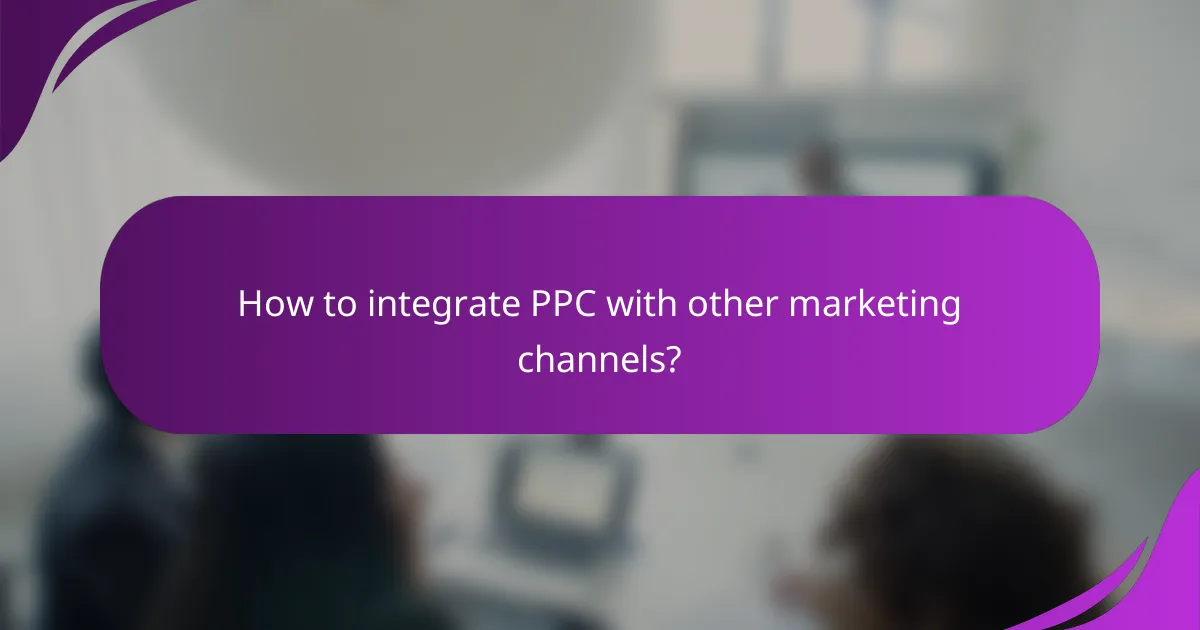
How to integrate PPC with other marketing channels?
Integrating PPC with other marketing channels enhances overall campaign effectiveness by creating a cohesive strategy. This approach allows for better audience targeting, improved budget allocation, and maximized performance across platforms.
Cross-channel marketing strategies
Cross-channel marketing involves coordinating PPC efforts with other channels like email, social media, and content marketing. This ensures consistent messaging and reinforces brand recognition, leading to higher conversion rates.
For example, using PPC ads to promote a new product can be complemented by email campaigns that provide additional information or special offers. This synergy can increase customer engagement and drive sales more effectively than isolated efforts.
Retargeting techniques
Retargeting is a powerful technique that allows marketers to reach users who have previously interacted with their brand but did not convert. By displaying targeted ads to these users across various platforms, businesses can remind them of their interest and encourage them to complete a purchase.
Effective retargeting strategies include segmenting audiences based on their behavior, such as pages visited or products viewed. This allows for personalized messaging that resonates more with potential customers, increasing the likelihood of conversion.
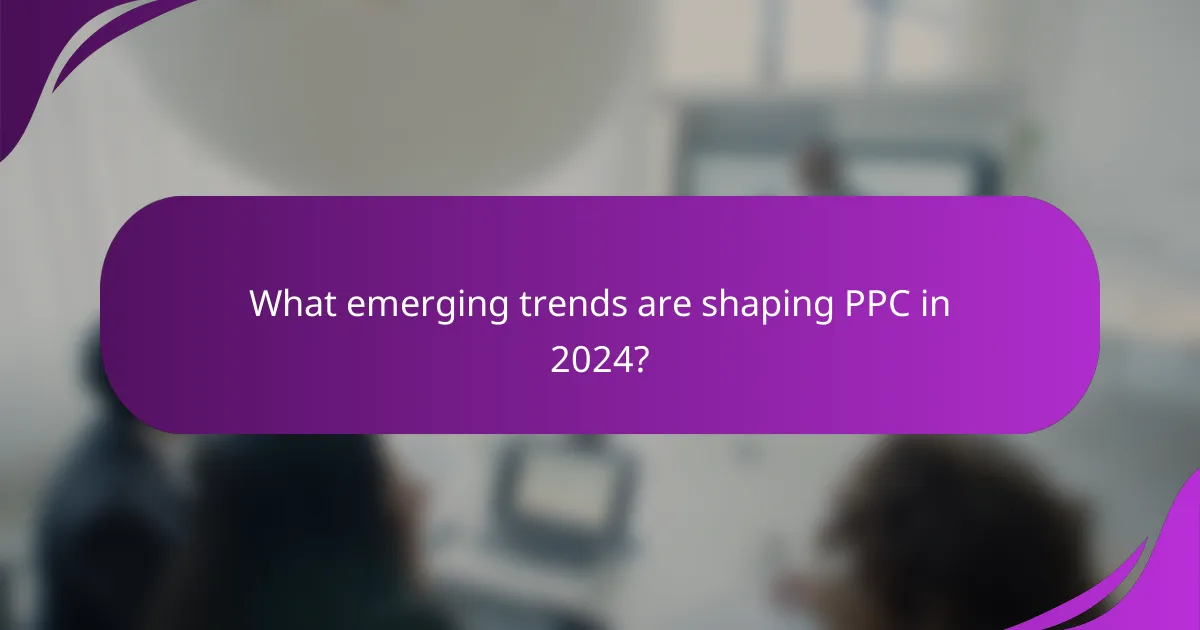
What emerging trends are shaping PPC in 2024?
In 2024, PPC campaigns are increasingly influenced by advancements in technology and changing consumer behavior. Key trends include AI-driven bidding strategies, voice search optimization, and a heightened focus on video ads, all of which can significantly enhance campaign performance.
AI-driven bidding strategies
AI-driven bidding strategies utilize machine learning algorithms to optimize ad placements and bids in real-time. These strategies analyze vast amounts of data to predict the best bidding amounts based on user behavior and market conditions.
Advertisers should consider implementing automated bidding options, such as Target CPA or Target ROAS, which can help maximize conversions while staying within budget. However, it’s crucial to monitor performance closely, as automated systems may require adjustments based on campaign goals.
Voice search optimization
Voice search optimization is becoming essential as more consumers use voice-activated devices for online searches. This trend requires advertisers to adapt their PPC strategies to accommodate natural language queries and conversational phrases.
To optimize for voice search, focus on long-tail keywords and question-based queries that reflect how users speak. Additionally, ensure that your landing pages provide clear, concise answers to common questions, enhancing the likelihood of conversions from voice search traffic.
Increased focus on video ads
Video ads are gaining traction as a powerful format for engaging audiences and conveying messages effectively. With platforms like YouTube and social media prioritizing video content, advertisers are shifting budgets to capitalize on this trend.
Consider creating short, compelling video ads that capture attention quickly, ideally within the first few seconds. Additionally, utilize targeting options available on video platforms to reach specific demographics, ensuring your ads are seen by the most relevant audiences.
